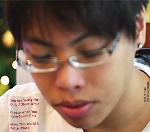A BUSY CLAWING CAT
Dr
Sing Kong Yuen, BVMS (Glasgow), MRCVS
Saturday
11 July, 2010 |
 toapayohvets.com toapayohvets.com
Be Kind To Pets
Veterinary Education
Project 2010-0129 |
Cat owners are
strongly discouraged in requesting declawing of cats.
Very rarely do I encounter declawing requests in my
surgery. Declawing will be done only if there are good
reasons. The couple had used anti-scratching medication,
nail covers and provided the scratching post. But the
active cat still scratches furniture and people.
For Toa Payoh Vets
Knowledge Management records, the following is
written to share knowledge similarly to
www.patientslikeme.com
Cat: British
Shorthair, Male, Neutered, 1 year, 4.8 kg, rectal temp:
38.3 degrees C
Anaesthesia: Xylazine 20@ 0.15 ml + Ketamine 100@
0.6 ml IM. Front paw hairs clipped.
The above dosage was insufficient for surgical
anaesthesia as clipping the soft furs in the paws took a
longer time than usual to clip. I had to use scissors as
well to get a clean hairless area for surgery. This
cat's paw hairs were like wool and the clipper could not
shave effectively.
Isoflurane gas top by mask for a few seconds was
effective.
Surgery: Rubber band tourniquet Electro-incision
was used. However, it was not practical due to the need
to trim at an angle of 45 degrees ventrally from the
posterior end of phalanx 2 with the claw in extension. A
bone cutter was used. 3-4 stitches of 3/0 absorbable
sutures closed wound.
Bandaging: Gauze was applied to the front of the
paws while the rubber band tourniquet was cut. Blood
flowed freely. Then a elastic bandage wrapped the gauze
and the paws (picture). A strip of sticky bandage around
the end of the elastic bandage was used to prevent the
cat pulling off the whole bandage.
Pain killers:
Tolfedine injection (0.5ml and then tolfedine tablets x
4 days (3 tab of 6 mg/day). Injection and oral dosage is
the same, at 4mg/kg. Baytril @ 0.5 ml SC after surgery
and 1/2 tab/day for 4 days.
The cat went home on Day 1 as the owners wished. I
advised to be crated or confined to a small room.
However, the cat was active and kept flinging his paws.
So he was warded at Toa Payoh Vets for 4 days.
On Day 2, the bandage was taken off to review the
paws for bleeding. Not a drop of bleeding as the
bandaging was tight but not too tight to cause paw
swelling. So, the cat was given a bigger e-collar. With
NSAID tolfedine being effective in this case, the cat
was not bothering her front paws.
Unusual
Complication: Part of the right whiskers of the cat
was clipped off inadvertently. This was discovered by
the owner. As it was difficult to clip the woolly fur of
the paws and the cat was sedated with his head to the
right side, near his right fore paw, the clipper must
have accidentally clipped part of the whiskers.
 In
future, it would be best for one person to hold the head
up during clipping of the paws. In
future, it would be best for one person to hold the head
up during clipping of the paws.
Outcome. The results were excellent. Apologies were made
for the clipping of the right whiskers.
P.S. For a successful outcome, it is best not to
permit the cat to go home immediately. Some owners don't
know how to do post-surgical nursing and checking or
give the medication. The cat may pull out the bandage
and lick the wound. Some owners don't bother to phone up
the vet and when they do, it is too late as the paw has
been badly infected. The paws may also gangrenous.
Therefore I advise more than 4 days for observation.
That cat had no problems and the owner was advised that
the 3/0 absorbable stitches would fall out by
themselves. So he did not need to come for stitch
removal.
|
|
More info at:
Dogs or
Cats
To
make an appointment: e-mail
judy@toapayohvets.com
tel: +65 9668-6469, 6254-3326 |
 toapayohvets.com toapayohvets.com
Be Kind To Pets
Veterinary Education
Project 2010-0129 |
|
|
 Toa
Payoh Vets Toa
Payoh Vets
Clinical Research
|
|
|
Copyright ©
Asiahomes Internet
All rights reserved. Revised: July 11, 2010
Toa Payoh Vets
| |
 TOA
PAYOH VETS
TOA
PAYOH VETS TOA
PAYOH VETS
TOA
PAYOH VETS